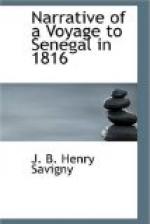Madeira appears like an amphitheatre; the country houses which cover it seem to be in a very good taste, and give it a charming appearance. All these delightful habitations are surrounded by fine gardens, and fields covered with orange and lemon trees, which when the wind blows from the shore, diffuse for full half a league in the open sea, the most agreeable perfume. The hills are covered with vineyards, bordered with banian trees: in short every thing is combined to render Madeira one of the most beautiful islands of Africa. Its soil is only a vegetable sand, mixed with an ash, which gives it astonishing fertility; it shews every where nothing but the remains of a volcanised earth, the colour of which is that of the element, by which it was long consumed. Funchal, the capital town of the islands is situated in long. 19 deg.. 20’. 30.” in lat. 32 deg. 37’. 40”. This town is far from handsome, the streets are narrow and the houses in general ill built: the highest part of the island is the Pic de Ruvio, which rises about two hundred metres above the level of the sea. The population of Madeira is from 85,000 to 90,000, inhabitants as we are assured by a person worthy of credit, who has resided for some time in that fine colony.
We sailed in this manner along the coast of Madeira, because the intention of the commander was to send a boat on shore for refreshments; but being surprised by a calm under the land, we were afraid of approaching too near, lest we should not be able to stem the strong currents which set towards it. A gentle breeze arising, enabled us to get out to sea, where the wind became favorable, and pretty brisk; it was resolved that the boat should not go on shore: and we resumed our course going at eight knots. We had remained three hours opposite Funchal bay. At nightfall Madeira was in full sight: the next morning at sun-rise we saw the islands called Salvages, and in the evening we descried the Pico of Teneriffe, on the island of that name. This lofty mountain, behind which the sun had just set, presented a sight truly magnificent; its summit seemed to be crowned with fire: its elevation above the level of the sea, is 3711 metres; it is situated in lat. 28 deg. 17’ and in long. 19 deg.. Several persons on board affirmed that they saw the Pico at eight o’clock in the morning; and yet we were at least thirty leagues distant from it; the sky it is true, was extremely clear.
The commander resolved to send a boat to St. Croix, one of the principal towns in the island, to fetch fruits, and some filtering stones, which are made in that town; they are only a kind of mortar, made of the volcanic stone of the country. In consequence, during the whole night we made short tacks; the next morning we coasted the island, at the distance of two musket shot, and passed under the guns of a little fort, called Fort Francais. One of our companions leaped for joy, at the sight of this little fort, which was raised in haste by a few Frenchmen, when the English, under Admiral Nelson, attempted to take possession of the Colony. It was there, said he, that a numerous fleet, commanded by one of the bravest Admirals of the English navy, failed before a handful of French, who covered themselves with glory and saved Teneriffe; the Admiral was obliged to take flight, after having lost an arm in the contest, which was long and obstinate.




